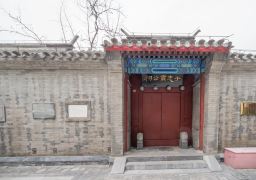The architectural style of the Huang Gongwang Memorial Hall is an antique-style building that integrates ancient and modern elements. It extracts relevant elements from paintings remaining from the Song, Yuan and Ming dynasties, and combines the design concepts of modern designers. The pillars in the corridor at the entrance are all made of woods such as meranti wood, which is magnificent. The several characters of the museum name are from the hand of Rao Zongyi, a master of Chinese studies and the president of Xiling Seal Engravers Society. The entire memorial hall is divided into one foyer and three exhibition halls. At the end of the foyer corridor, there are two stones called ‘Five Cranes and Auspicious Clouds’. The stones are carved with white cranes. On the wall above the stones is a folk-style poem: ‘Once upon a time, there was a Baihe Pier by the Fuchun River. Beside Baihe Pier, there was a Miaoshanwu. Inside Miaoshanwu, there was a small fairyland…’; this is the scene that tourists see first when entering the exhibition hall. On the right side of the foyer, a thousand-year-old shade-formed wood is used to create a scene, giving people who see it a sense of historical vicissitudes and seclusion in the mountains and forests, serving as an introduction to the exhibition halls. The first hall is a video hall. Here, tourists can enjoy the beautiful scenery of Fuyang and some cultural materials related to ‘Dwelling in the Fuchun Mountains’ and Huang Gongwang. It reflects Huang Gongwang’s legendary life from his birth to adoption, from his erudition in childhood to being a clerk twice, and being implicated and imprisoned in a form with pictures and texts. The second hall is a more important part of the entire memorial hall. On the west wall of this hall, a slender branch-like strip winds on the wall, reflecting the legendary experience (time nodes) of the painting scroll ‘Dwelling in the Fuchun Mountains’. Starting from when Huang Gongwang painted ‘Dwelling in the Fuchun Mountains’ and passed it to the first collector, Wuyong Shi, until the eight time nodes in the middle of the divided two sides are fully exposed. On the cabinet by the wall, the ‘Ziming Scroll’ that Emperor Qianlong mistook for the authentic work in 1745 is exhibited. Hanging on the east wall of the exhibition hall is the hundred-family commentary. Here, the comments of 16 famous masters throughout history on Huang Gongwang’s painting techniques and his works are hung. On the cabinet on the east wall is the imitation ‘Dwelling in the Fuchun Mountains’ scroll by Shen Zhou of the Ming Dynasty. In the center of the hall, displayed in the painting cabinet are the ‘Surviving Mountain Picture’ and the ‘Wuyong Shi Scroll’ in ‘Dwelling in the Fuchun Mountains’. The interesting thing about this hall is these three works displayed in the hall. Looking at Shen Zhou’s one, you can know the burned parts in the ‘Surviving Mountain Picture’ and the ‘Wuyong Shi Scroll’; looking at the ‘Ziming Scroll’, you can think of the ‘Wuyong Shi Scroll’ that escaped disaster, because the ‘Ziming Scroll’ is densely covered with imperial viewing pictures and inscriptions by Emperor Qianlong. The third hall mainly reflects Huang Gongwang’s artistic achievements. One is his painting theory ‘Secret Instructions on Landscape Painting’, and the other is eight high-quality imitations of Huang Gongwang’s surviving paintings. Another part is the ‘Fuchun Sentiment’ section reflecting Fuyang’s mental journey of promoting the’reunion of mountains and waters (reunion)’ over the years.
The opening hours are from 08:30 to 16:30 from Tuesday to Sunday throughout the year.
It is closed all day on Monday throughout the year.








